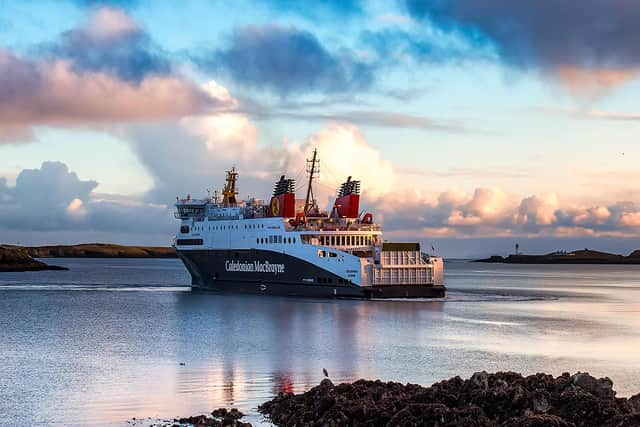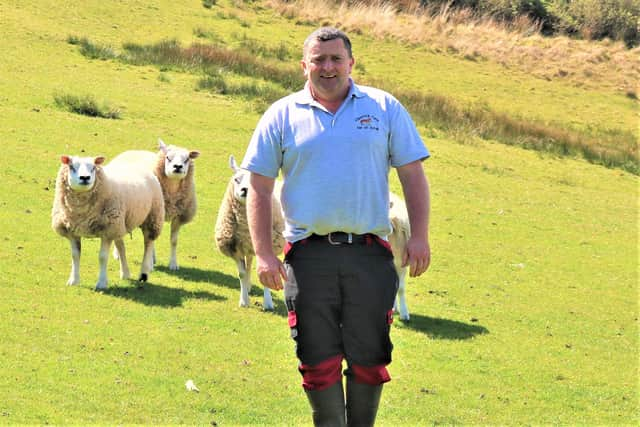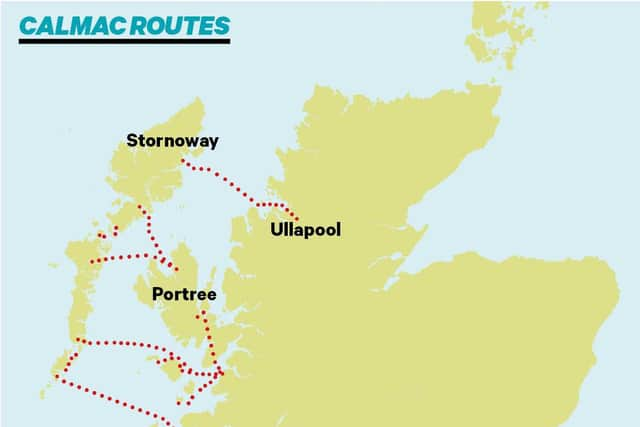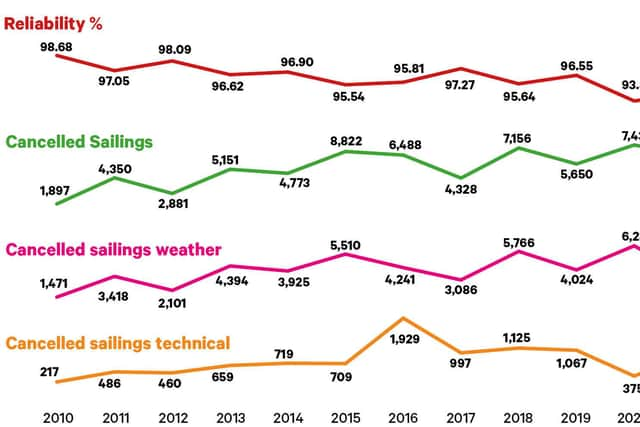Insight: Future of CalMac ferry service under scrutiny as islanders' frustration mounts
But many residents of the Hebrides won’t be feeling very special, despite that unusually lyrical official description, because of the turmoil caused to a central feature of their island existence – the ferry service.
For 170 years, Caledonian MacBrayne and its forebears have provided the islanders’ main link to the mainland, and in some cases their sole one.
Advertisement
Hide AdAdvertisement
Hide AdIts services comprise the UK’s largest ferry operation, with a network of 29 routes stretching from Stornoway to Campbeltown.


However, those “lifeline” links are coming under increasing strain, not least because CalMac’s fleet is ageing, with only 13 vessels introduced in the last 20 years compared to 19 in the previous two decades, and 40 in the same period before that.
In 2001, its longest-serving ferry was 28 years old. The oldest is now 44 years old, and average age is 22 years.
On top of that, CalMac has struggled to cope with demand on some routes from traffic growth fuelled by fare cuts of up to 40 per cent for cars after ministers sought to align the cost of sea and road travel.
Then the Covid pandemic struck, with capacity cut by 80 per cent, and some desperate travellers resorting to becoming stowaways in the back of vehicles.


To make matters worse, a series of significant vessel breakdowns has exposed the fragility of the fleet, whose resilience has been further tested by major delays to the introduction of two key new large ferries that should have started serving some of its busiest routes three years ago.
This has contributed to service reliability up to September falling to 94.6 per cent, nearly two points below the pre-Covid pandemic performance and well down on the 97-98 per cent level of a decade ago.
But in a small boost, a second-hand Norwegian ferry has been acquired to bolster the fleet following a worldwide search.
Advertisement
Hide AdAdvertisement
Hide AdUtne is due to sail from Rosyth to Leith this weekend ahead of modifications prior to planned deployment on the Oban-Mull route next year.


Familiarity breeds contempt
For regular CalMac passengers, familiarity breeds contempt, and the islands and peninsulas’ inextricable links with their black, white and red-liveried ferries mean dependence and anguish in equal measure.
While CalMac’s cheery staff and renowned customer service are praised by many holidaymakers and day trippers, some locals have a more jaundiced view of the company’s performance when chronic disruption threatens to ruin livelihoods not just leisure jaunts.
Among them is Arran farmer David Henderson, who said he was fighting a “constant battle” to get animal feed and livestock on and off the island.


Arran was hit by the knock-on effect of Loch Seaforth, CalMac’s newest and biggest ferry, being out of action for nearly two months this year, when one of its vessels was redeployed to fill the gap on the Ullapool-Stornoway route.
It left the main Ardrossan-Brodick route with a reduced service from April, just as islanders were struggling to recover from the Covid pandemic.
Henderson, who represents the National Farmers Union of Scotland on the Arran Ferry Committee, said: “The local staff are always very good at trying to get you onto boats – the problem lies at the top of the tree.
“Last week, we had sheep ready to go to market, but the ferry refused to take livestock, so it meant we had to keep them an extra week at a cost and then hope we can get a booking for the following week – or that it sails."
Advertisement
Hide AdAdvertisement
Hide AdHe said the alternative was taking livestock the long way round via the island’s other ferry route, west to Tarbert, which added up to £250 because of the extra distance to markets in Stirling or Ayr.
He added: "We are struggling to get feed and supplies over due to ferry unavailability.


“The vet is also not being able to book to come over on the first ferry of the day, a whole month in advance.
“The whole set up is failing and it is putting companies off dealing with Arran farmers.
“It has been getting worse and worse each year."
‘Huge reputational damage’
Sheila Gilmore, chief executive of VisitArran and the Arran Trust, which represents tourism businesses, said a survey last week showed 90 per cent had been affected by ferry disruption.
She said: “Islanders have put up with a great deal of frustration and this is increasing.
"We have a more unreliable service now than we did 20 years ago.
"Cancelled sailings are causing Arran huge reputational damage.”
Advertisement
Hide AdAdvertisement
Hide AdThe island should have received its new ferry – Glen Sannox (or “hull 801”) – in 2018, but because of well-documented problems at the Ferguson Marine shipyard in Port Glasgow, the vessel is not now due to be delivered until between July and September next year.
Its as-yet unnamed sister vessel, currently known as hull 802, which is earmarked for the “Uig triangle” route between Skye, Harris and North Uist, will be even later, and is now scheduled to be completed between April and July 2023 – five years behind schedule.
Experts have predicted the final cost could be more than triple the original £97 million contract.
The ferries form part of Scottish Government agency Transport Scotland’s Vessel Replacement and Deployment Plan, which was last updated three years ago and which it said would be followed by a new “long-term plan and investment programme for new ferries and development at ports”.
Spending of “at least £580 million during the next five years” was pledged in February.
This will include on the two delayed ferries, two new vessels for Islay and Jura, three new ferries for the passenger-only Gourock to Dunoon and Kilcreggan routes, and others for the Mallaig-Armadale/Lochboisdale and Oban-Mull routes.
Up to seven of the smallest vehicle-carrying ferries, which are up to 44 years old, are also due to be replaced by 2030.
Among the bewildering number of other official documents involved is the National Islands Plan, while an Islands Connectivity Plan is due to succeed the current Ferries Plan 2013-22 – and ministers’ latest Strategic Transport Projects Review (STPR2) also includes plans for the ferries.
Advertisement
Hide AdAdvertisement
Hide AdDespite all this apparent activity, both islanders and experts have questioned both the way the ferry system is controlled and the types of vessels likely to be ordered.
Project Neptune
CalMac is the Scottish Government-owned operator of the current eight-year ferry contract, awarded by Transport Scotland after a competition with private sector operator Serco and due to end in 2024.
Its vessels and some of the ports they use are owned by a separate Scottish Government firm, Caledonian Maritime Assets Limited (Cmal).
However, that structure could yet be torn up because ministers have commissioned a review, code named Project Neptune, by consultants Ernst & Young, “mindful of the perception which exists of a lack of accountability among the three parties”.
Its recommendations are due to include “optimal corporate structures and governance arrangements”.
Provisional findings are due to be delivered “around the end of the year”, transport minister Graeme Dey said in August.
But critics include Gilmore of VisitArran, who said: “CalMac are the operators, Cmal own the infrastructure - the aged ferries and some of the ports - and Transport Scotland is the agency they report to.
"This triangular approach is time wasting and confusing for all involved.
Advertisement
Hide AdAdvertisement
Hide Ad"You go to one agency to be told it's the responsibility of the other.
‘No reason to exist’
“Throw into the mix the Maritime and Coastguard Agency [which is responsible for safety], and you've basically got a big guddle.”
Joe Reade, chair of the Mull & Iona Ferry Committee, agreed.
He said: "We have three different state agencies, but it’s not clear who is actually responsible for deciding ferries policy.
"It is a bizarre arrangement where the ferry operator and ferry owner are separate companies, not replicated anywhere else.
"Cmal needs to go. There is no legal or logical reason for it to exist.”
Reade, who is also director of Island Bakery Organics in Tobermory, added: "The one source of independent professional advice they had – the Ferry Industry Advisory Group – hasn’t met for more than two years.”
Several expert members of that group were vitriolic in their criticism of the ferry setup.
Advertisement
Hide AdAdvertisement
Hide AdConsultant Roy Pedersen said: "Most Scottish ferry operators provide efficient and reliable services, but the state-funded Clyde and Hebrides services [operated by CalMac] figures very poorly in terms of lack of capacity, unreliability, inconvenient scheduling with little cognisance of island community needs and very high cost to the taxpayer – in short abysmal productivity.”
He said the planned new Islay ferries, capable of carrying 350 passengers and 107 cars at a cost of £50 million each, would have a crew of 27 including 11 catering personnel.
‘Catastrophic failure’
By comparison, he said privately-run Pentland Ferries, which operates between Caithness and Orkney, had 13-14 crew, including one or two for catering. on its 430-passenger, 98-car ferry Alfred, which cost £14m.
Alf Baird, a former professor of maritime business at Edinburgh Napier University, said: “From an international ferry industry perspective, what the Scottish Government and its ferry agencies are doing seems like economic and commercial madness.
"The Holyrood committee of MSPs investigating the ferries procurement were right to describe the ongoing delay and cost overruns debacle surrounding ferry hulls 801/02 as a ‘catastrophic failure’.
"However, the real worry is that those same people responsible for that ‘catastrophic failure’, as reflecting the absence of any accountability in the matter, appear to be about to do more of the same, unless a different approach is taken.”
Baird said a proven, rather than bespoke design should have been chosen.
He said: "We might imagine for a moment the challenge and risks in designing and building an entirely new car model, which is twice as heavy as standard models, as opposed to simply buying a proven, guaranteed Ford Fiesta from a car showroom for a third of the price.
‘End monopoly’
Advertisement
Hide AdAdvertisement
Hide Ad"Cmal/CalMac and the Scottish Government opt to do the former, which explains why it costs three times more and results in horrendous ongoing problems, with added risks and costs over the ship’s lifetime.
"This also helps explain why Scotland has the highest ferry subsidies in the world and simultaneously one of the most outdated and irregular ferry fleets.”
On Mull, Reade called for an end to CalMac’s monopoly.
He said: "We need the operator to have an incentive to improve services, find economies and efficiencies, become more productive, and spend taxpayer money to better effect.
"The only way those things can be encouraged is by the introduction of some competition into the system."
Reade said competition in Norway had resulted in “the best provisioned, most efficient and well-invested public ferry networks in Europe”.
He said: “The idea of breaking up CalMac would be controversial to some, but the superiority of the Norwegian system is undeniable.”
The STPR2 transport strategy acknowledged the challenges islanders were facing, especially since 2015 when the lower “road equivalent tariff” fares covered the whole CalMac network.
It noted: “During periods of peak demand and at popular times, many of the primary ferry services to the larger islands are operating at, or close to, full vehicle capacity, with island residents and businesses struggling to book vehicle spaces during periods of peak demand, creating disruption and delay.”
Advertisement
Hide AdAdvertisement
Hide AdThese included the main routes to Arran, Islay and Mull, and Mallaig-Lochboisdale, Uig-Tarbert-Lochmaddy, Stornoway-Ullapool and Armadale-Mallaig.
Pre-pandemic, 1.5m cars were carried on CalMac ferries in 2019, 4.5 per cent more than the previous year.
While the total fell during last year’s lockdowns, it is again on the rise, with 156,000 cars carried in September – the latest available figures – 5 per cent more than a year ago.
Lord Robertson, chair of privately-run Western Ferries, which operates between Gourock-Dunoon, said some CalMac routes should adopt its high-frequency, no-frills approach.
The Labour peer said: "The model is entirely wrong.
"What people want are fast, reliable, frequent services.
"We have a roll-on operation - you drive on and you drive off.
‘Huge impact’
"It's got passenger accommodation and toilets but it doesn't have any restaurants or the rest of it.”
CalMac managing director Robbie Drummond said: “I apologise unreservedly for the disruption that our customers have been experiencing.
"We strive to provide the best service possible and I am sorry that this has not always happened.
Advertisement
Hide AdAdvertisement
Hide Ad“The Covid pandemic continues to have a huge impact due to positive cases in ports, vessels and within customer care teams.
"The rules surrounding close contacts mean that we sometimes do not have enough crew to legally operate vessels, leading to delays or cancellations.
“Traffic volumes have also more than doubled in the past five years, which has led to capacity issues as our vessels are stretched to the limit of operational capability.
"The good news is that four new large ferries – MV Glen Sannox, the 802 and two for the Islay route – and several smaller vessels, are on the horizon, with consideration now turning to new ferry options for Mull.
"This much-needed investment will significantly improve the service.”
Tommy Gore, CalMac’s area operations manager (Clyde) said he understood Henderson’s frustration.
He said: “I apologise for the disruption that this can cause to local farmers.
"Decisions not to take livestock are only ever taken with the safety of livestock in mind.”
Advertisement
Hide AdAdvertisement
Hide AdA spokesperson for Cmal said it had called for the ferry replacement plans to be accelerated and that had been “recognised” by the Scottish Government in its plans for the next five years.
On ferry size, it said: “Vessel choice is informed by a wide range of factors such as current passenger and freight demand as well as future projections, comfort, safety, reliability, sustainability, efficiency and cost.”
The spokesperson said Cmal added “considerable value” and was the “only organisation in the public sector in Scotland that possesses the professional and technical skill, expertise and experience to manage large vessel and harbour infrastructure projects.
“This professional resource is critical to maintaining and improving Scotland’s ferry infrastructure.
"The job can’t be done effectively without our team’s contribution.”
‘Significant opportunity’
A Transport Scotland spokesperson said ministers “set the policy context and strategic outcomes for ferry services” which had led to new services to Campbeltown and Lochboisdale, and “increased sailings and capacity on key services including those to Arran, Mull, Islay and the Western Isles”.
It said there would be “significant opportunity for CalMac and Cmal, alongside other stakeholders and – most importantly – users and communities, to input to the formulation of future policy.”
The spokesperson said the Project Neptune report “will present a framework consisting of a range of options designed to enhance the functioning of the tripartite governance arrangement [with Cmal and CMac]”.
A message from the Editor:
Thank you for reading this article. We're more reliant on your support than ever as the shift in consumer habits brought about by Coronavirus impacts our advertisers.
If you haven't already, please consider supporting our trusted, fact-checked journalism by taking out a digital subscription.
Comments
Want to join the conversation? Please or to comment on this article.